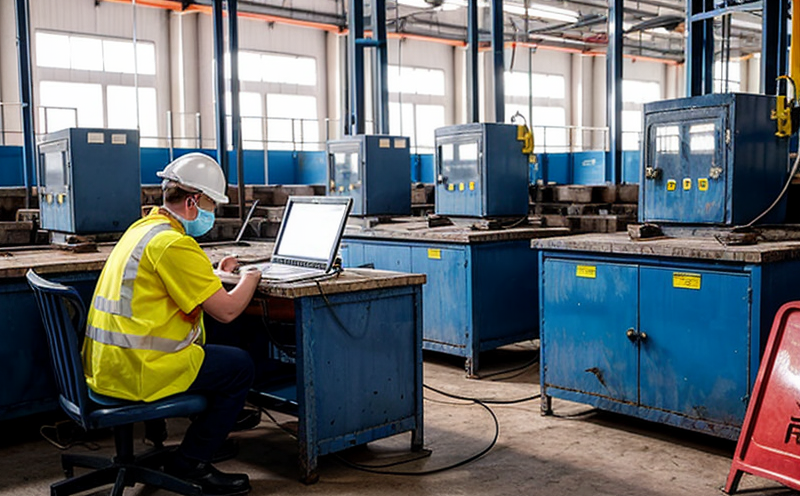EN 166 Eye Protection Testing for Industrial Workplaces
The European Standard EN 166:2008 sets out requirements and test methods for eye protection devices used in various industrial environments. This standard is crucial for ensuring that workers are adequately protected from potential hazards such as splashes, dust, particles, and impact risks. In the context of industrial manufacturing and processing testing, especially within factories, EN 166 compliance ensures that occupational health and safety standards are met. Here, we delve into the specifics of this standard and its application in real-world scenarios.
EN 166 covers a wide range of eye protection devices including goggles, visors, spectacles, and face shields. The standard specifies essential parameters such as visual properties (transparency, color, contrast), optical density, resistance to impact by particles or liquid droplets, penetration by dust and splashes, as well as the fit of the device on the wearer’s head.
Testing for compliance with EN 166 involves several stages. Initially, devices are subjected to visual inspection followed by functional testing. This includes pressure tests to ensure that the device can withstand specified levels of impact without compromising its integrity. Additionally, there is a test for optical density which checks if the lens or visor allows sufficient visibility while still providing adequate protection.
The standard also emphasizes fit and comfort. Manufacturers must provide detailed information about how their products fit different head sizes to ensure they do not cause discomfort during prolonged use. This aspect is particularly important in industrial settings where workers spend extended periods wearing protective gear.
Compliance with EN 166 goes beyond just meeting the minimum requirements; it signifies a commitment to worker safety and well-being. By adhering strictly to these standards, employers can demonstrate their dedication to creating safe working environments that protect employees from avoidable injuries caused by eye hazards.
In summary, EN 166 plays an essential role in safeguarding industrial workers against potential eye injuries. It provides a comprehensive framework for designing and manufacturing protective eyewear suitable for various industrial tasks. Adherence to this standard helps maintain high standards of occupational health and safety within factories, contributing significantly to overall productivity and employee satisfaction.
Benefits
Implementing EN 166 eye protection testing offers numerous benefits for both employers and employees:
- Enhanced Safety: Ensures that workers have appropriate protection against common industrial hazards like dust, particles, and impact risks.
- Regulatory Compliance: Helps organizations meet international safety standards, thereby avoiding penalties and fines associated with non-compliance.
- Better Decision Making: Provides accurate data on the performance of protective eyewear which aids in selecting the most effective products for specific tasks.
- Increased Productivity: Reduces downtime due to injuries, leading to higher operational efficiency.
The standard also promotes a culture of safety within the organization. By prioritizing employee well-being through proper eye protection, companies foster trust and loyalty among their workforce. This not only improves job satisfaction but also contributes positively towards corporate image and reputation.
Industry Applications
In industrial manufacturing and processing, occupational health & safety testing is vital for maintaining a safe working environment. One key component of this is ensuring that employees wear suitable eye protection against various hazards present in factories. Here are some specific applications where EN 166 compliance plays a critical role:
- Manufacturing Floors: Workers on the manufacturing floor often face risks from flying debris, chemical splashes, and sparks. Properly tested eyewear ensures they remain safe during these activities.
- Assembly Lines: Assembling intricate components requires precision; however, it also exposes workers to potential eye injuries. Protective gear that meets EN 166 standards provides the necessary defense.
- Chemical Plants: Handling hazardous chemicals demands robust protection. Eye protection devices tested according to EN 166 help safeguard against chemical splashes and fumes.
In all these scenarios, meeting the requirements of EN 166 not only protects workers but also aligns with broader goals of improving workplace safety practices. It fosters a culture where every effort is made to prevent accidents that could otherwise disrupt operations or compromise employee health.
Competitive Advantage and Market Impact
Adherence to EN 166 not only enhances worker safety but also provides significant competitive advantages in the industrial sector:
- Innovation Leadership: Organizations that comply with these standards can innovate more freely within safe parameters, knowing their products meet stringent international benchmarks.
- Better Brand Reputation: Companies demonstrating commitment to employee welfare through rigorous testing are viewed favorably by consumers and investors alike.
- Customer Trust: Providing evidence of EN 166 compliance builds trust among clients who prioritize safety in their operations.
The market impact is profound as well. Meeting this standard can open new opportunities for business growth, especially when targeting international markets that require stringent safety measures. It also helps maintain a competitive edge by setting higher standards than some local regulations might demand.





